Bauma show guide: Showing the world
25 March 2019
From 8 to 14 April 2019 Bauma exhibition attendees will be treated to a vast display of the latest and greatest products and services on offer from manufacturers worldwide for the construction industry.
It will be the 32nd iteration of the trade fair for construction machinery, building material machines, mining machines, construction vehicles and construction equipment. More than 5,500 exhibitors will display their wares over a total display area of 614,000 square metres. The last show, in 2016, attracted a spectacular 583,736 visitors and more are expected this year.
As the world’s largest crane maker, visitors will be unsurprised to learn that Liebherr is a leading exhibitor. The well-known stand on a prime plot in the outside area covers more than 14,000 square metres. As that wasn’t enough there is an additional, indoor, stand in Hall A4. More than 60 exhibits, including many cranes will be outside while components, condition monitoring and system solutions, among others, will be the focus on the indoor stand.
Expect similar, if smaller scale, displays from the other crane makers, specialized transport equipment builders and the vast majority of manufacturers of components, parts, accessories and services.
If you attend the show you are more than welcome to visit the KHL stand, in Hall B5, stand number 401 where you can meet the ICST team, have a drink and take the weight off your feet. What follows is a selection of products and services on show from manufacturers and providers all over the world.
Wheeled mobile cranes
Liebherr said it will show four new wheeled mobile cranes with a focus on high performance and economy. The previously unseen highlights will be new 8-axle and 5-axle wheeled mobile telescopic cranes. The larger one is designed for maximum performance and the smaller one to offer great economy and flexibility in use, the manufacturer said.
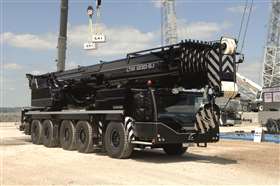
A new but previously seen wheeled mobile making its public debut is the five axle 230 tonne capacity LTM 1230-5.1 which is already on sale around the world. It has a 75 metre boom and replaces the LTM 1200-5.1. Also, it is the first to have an asymmetrical outrigger support base: 7.4 m at the front and 8.1 m at the rear. Liebherr calls this facility, a combination of the trapezoidal and the variable support base, VarioBase Plus.
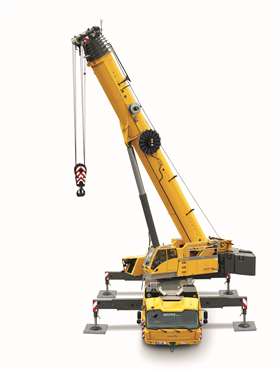
New all terrain cranes from Manitowoc will include the 300 tonne capacity Grove GMK6300L-1, successor to the GMK6300L, a new GMK4090 and a new 60 tonne capacity GMK3060L. This latter machine is an upgrade of the three-axle Grove GMK3060 which was launched at the same show in 2013. A primary change is the 5 metre longer boom, now 48 instead of 43 m. The extra is achieved by adding a 7th section. Manitowoc hails it as offering “the strongest taxi load charts in its class.”
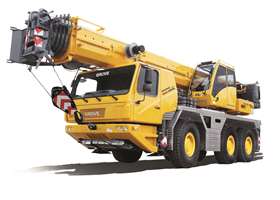
The Grove GMK3060L has a 5 metre longer boom than the GMK3060 it replaces
Its chassis is almost as compact as a two-axle crane, the manufacturer says and, with an 8.68 m carrier length, it is as much as 1 m shorter than competitors. With a new engine the power output is higher while exhaust pollution is lower, the company claims. It has the Maxbase option of variable outrigger settings to increase capacity in certain working ranges.
The GMK3060L is powered by a Cummins QSL9, a 254 kW (340 hp) six-cylinder in-line diesel engine. Improved fuel consumption is a primary benefit of the new engine. The QSL9 offers a compact footprint one of the best power-to-weight ratios in its class, the company said. It will be available in both Euromot III/Tier 3 and Euromot V/Tier 4 Final variants. Drive is via a ZF TraXon automatic transmission, giving 12 forward gears and two reverse.
New and existing all terrain crane models will be shown by Tadano Faun. The new ATF 60G-3 will be joined by two more new units, on four and five axle carriers. Tadano said these will set new standards in their categories. Details will be published as they become available. On show from the upper end of the range of existing models will be the ATF 400G-6 which has improved capacity when using a jib.
Also on show from Tadano will be a 40 tonne capacity HK 40 truck mounted crane and a pair of rough terrains, the GR-1200XL and a GR-200EX. Visitors will also be able to see a GT-750EL truck crane on a carrier made for markets outside Europe.
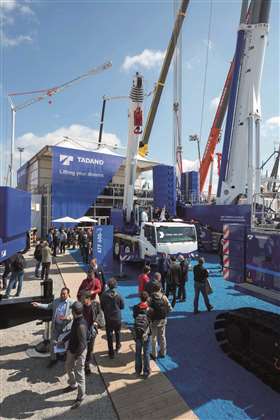
Tadano is also offering tours of its all terrain crane factory at Lauf throughout the week via a free shuttle bus service for the 185 km, two-hour, journey.
At Terex there is a focus on making cranes easy and efficient to transport, set-up and handle, the company says, “That’s why since Bauma 2016 we’ve reignited our innovation engine and launched 15 new cranes and innovative new features like asymmetric outrigger positioning and boom booster, adding to our over 500 patents.”
The theme is to rethink, among other things, aspects of the products and ways of working with them, the company says. An example of this will be a new crawler crane so look out for that.
Crawler cranes

Early photo of the Kobelco 300 tonne capacity CKE3000G-2 from January 2018
A pair of G-2 series models will be the main attraction in the crane section of the Kobelco stand. They will be the 90 tonne capacity CKE900G-2 and the 300 tonne CKE3000G-2. The 90 tonner’s boom length spans from 12 to 61 m. It can lift 11 tonnes on the fixed jib and the maximum combination is 58 + 18.3 m. Power is from a 285 hp Hino diesel.
The CKE3000G-2 offers a boom length from 23.8 to 90 m. Its fixed jib offers a capacity of 26.6 tonnes and a maximum jib length of 30.48 m. The maximum boom and jib combination is 78 + 30.48 m, offering a total reach of 108.5 m.
Power is from a 450 hp Scania diesel. The main and auxiliary winches are offered in non-free fall or optional free fall capabilities, and a rated single-line line pull of 61,640 pounds-feet. It has an operating weight of 327 tonnes, a minimum car body transport weight of 42.5 tonnes and a maximum of 160 tonnes of counterweight.
Outstanding lifting capacities and low cost transport around the world are the main features cited by Liebherr for its new 800 tonne capacity lattice boom crawler crane. The LR 1800-1.0 was designed as a particularly powerful industrial crane for jobs with a luffing jib and derrick system, for example, in power plant construction and the petrochemicals industry. For the first time the boom system features lattice sections with three system dimensions which can be telescoped into each other for transport.
The Liebherr LR 1800-1.0 will be available for deliveries after the show. At the time of writing it was the most powerful crawler crane in its sector on the market, even though the basic machine is just 3 metres wide, the manufacturer explained. It is particularly rigid as a result of its increased design height. A quick connection to raise the superstructure for transport is standard.

The new 800 tonne capacity Liebherr LR 1800-1.0 crawler crane is designed to deliver maximum performance for industrial applications
Another feature of the LR 1800-1.0 is the derrick ballast with VarioTray. After raising the lattice boom with the large derrick ballast, part of that ballast is designed to be unbolted quickly and easily. Only a small proportion of the ballast is generally required for hoisting work with the boom fully or almost fully raised. It means tiresome stacking and unstacking of ballast slabs can be avoided.
A new type of ballasting system is used for the suspended ballast. It has an hydraulically adjustable folding frame to allow adjustment of the ballast radius up to 23 metres. A fixed guide frame system is no longer needed for large radii.
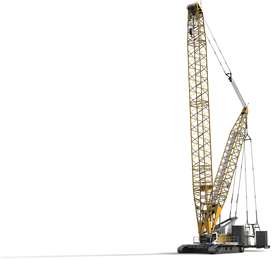
Another new Liebherr crawler is the 300 tonne capacity LR 1300 SX from the Nenzing factory in Austria. Developments include a range of assistance systems and a new cabin design. For heavy loads a derrick boom can be fitted in combination with additional counterweight. Its new suspended counterweight has hydraulically adjustable radius instead of being fixed.
For added safety when raising and lowering the boom, especially with a jib mounted, there is the new Boom Up-and-Down Aid assistance device. When approaching the tipping point the system automatically stops operation before the operator can enter an unsafe zone. It allows the operator to leave the “danger zone” without having to use the safety bypass switch.
Readings from wind sensors on the main boom and jib are combined with data of the crane configuration (boom length and boom angle) to calculate a hazardous situation. A warning is given when the condition becomes too dangerous and the operator can see the status in the cabin at all times, Liebherr said. When the wind speed is 10-16 m/s, the operator can adjust lifting capacity via a control panel. Also important is to monitor ground pressure. Readings from real time calculation are compared with the specified safety limits of the relevant position and are displayed for the operator.
The LR 1300 SX has EC type approval for the occasional lifting of personnel. It is a mode selected via a separate key switch. Part of the requirement is to have an emergency onboard generator and emergency controls. These are offered by Liebherr as a plug-and-play option.
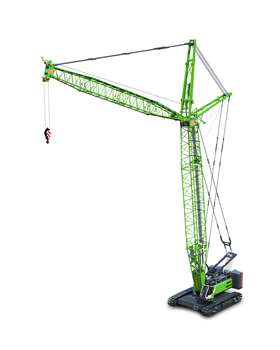
On show after receiving an upgrade will be Sennebogen’s 200 tonne capacity 5500G lattice boom crawler. As the 180 tonne capacity 5500 it was the first in the Star Lifter series. Now it has a 283 kW Tier 5 engine from Cummins and a G series designation. Versions with 180 or 200 tonnes capacity will be available. There is a pair of 160 kN winches and the crane can be driven under load. Between 15 and 50 % more capacity is available than its predecessor, depending on the chosen boom configuration.
There is a new strengthened boom design and more ballast. Maximum boom length is 104 m, including the luffing jib. With track frames removed the transport width is 3 m. Also new is the cabin design. Models to follow in the G series will be the 3300 and the 4400.
A new telescopic boom crawler on show will be the Sennebogen 6133E, the German manufacturer’s largest telescopic boom crawler to date. Capacity is 130 tonnes and its maximum reach on the main boom is 52 m.
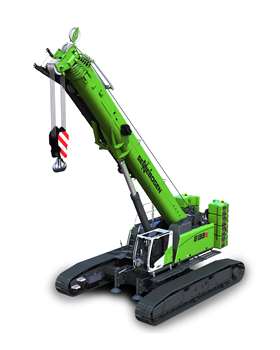
It has a telescoping undercarriage and simple self-assembly system to make it easy to transport.
Unlike other Sennebogen telescopic boom crawlers, the new one has a pinned boom instead of the full-power type. It is in six sections and is extended and retracted using one hydraulic cylinder. A 15 m fly jib gives a maximum reach of 67 m. It has more of a focus on lifting than being a foundation machine, Sennebogen says.
Power is from a 194 kW Tier 5 diesel engine and there is a pair of 125 kN winches. The Maxcab operator cabin can be tilted by up to 20 degrees. With the crawler frames and rear ballast removed the transport width is 3 m.
Sticking with telescopic boom crawlers but moving down the capacity scale, Tadano will show its 80 tonne capacity GTC 800 telescopic crawler which was recently made available in Europe. It was the best-selling model in 2018. The US-built machine is part of a five model series ranging in capacity from 35 to 120 tonnes. The 50 tonne model to complete the line was introduced in September 2018.

Smaller again and another development from Liebherr is an improved version of the HS 8040HD, the smallest duty cycle lattice boom crawler crane model in the HS series. This 40 tonner, also built in Austria, has a new cabin and new engine. Power is from a 230 kW Liebherr Tier 4 / Stage V diesel engine. It has two free-fall winches with 120 kN line pull each and the maximum main boom is 40 m.

The new Liebherr duty cycle crawler crane model
HS 8040 HD
Transport weight is less than 40 tonnes, including counterweight, for easy and flexible transfer between job sites. The improved A-frame system, with transport position to the front, shortens the transport length and simplifies erection or lowering of the boom. Handrails and walkways on the upper can be left in place for transport.
From China Sany will show its SCC1000 crawler crane and SRC800 rough terrain.
Tower cranes
Spanish tower manufacturer Comansa will share a stand with its German dealer, tower crane specialist BKL. They will share booth FS 1103/1 in the outdoor area for the third time. BKL owns around 500 tower cranes and has a wheeled mobile crane fleet of more than 100 units. More than 30 of the towers are from Comansa, with up to 50 tonnes capacity and 90 metre reach.
Comansa will show its new 50 tonne capacity 21LC1050 flat top tower available since September 2018. It offers a maximum radius of 80 metres and typical applications will be large industrial or infrastructure projects, construction with heavy precast or steel. The crane on show will join the BKL rental fleet.
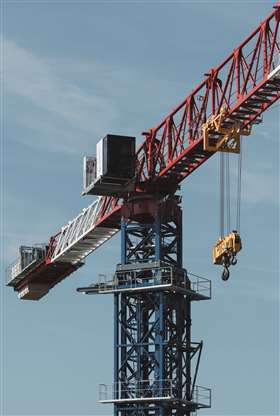
Another feature is the high speed hoist at up to 300 m/min and the drum capacity for 1,570 m of rope for high rise construction. It has a modular counter jib which allows six configurations to adapt the crane to specific jobs. Counter jib radius is 31 metres on the longest jib or 27 m when using the 50 m jib.
While not displaying them in the iron, fellow Spanish manufacturer Jaso will be promoting the two largest models in its tower crane line, the J1400 and J780. The 64 tonne capacity J1400 can have a jib up to 80 m. It has a tip load of 10.5 tonnes at 80 m. The J780PA is a 700 tonne-metre class model.
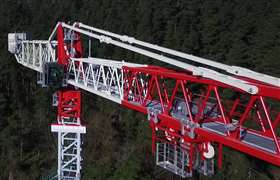
Jaso will intoduce its new JL25 operator elevator together with a redesigned construction hoist type GE1537. It is the first product from the new construction hoist line.
Manufacturer Saez, also from Spain, will have a new hydraulic luffer, the SLH 190. It is an 8 tonne capacity model. That is on four falls of rope and with the longest jib, of 50 metres, the maximum can be lifted out to 20 m radius while capacity at the end of the jib is 3,300 kg. Jib lengths can be adjusted in 5 m increments from 20 to 50 m. The mast is 2.1 m and the swing radius is 10.5 m. Hoist winch choices are 37 or 74 kW.

Big news from Liebherr is that it will launch a new EC-B series of flat top tower cranes. Eight models have been completed so far, covering a wide range of applications. Capacities are from 6 to 16 tonnes with a tip load range between 1.6 and 2.8 tonnes.
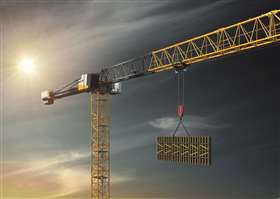
Three of the eight on show at Bauma will have synthetic fibre ropes and will be designated as such in the model nomenclature. They will be available for sale from April. It is the first tower crane series designed to maximise the benefits of the different properties of synthetic fire rope and its benefits over steel wire rope, Liebherr says.
Ropes made from synthetic fibre weigh just one-fifth of conventional steel rope but last four times longer and are much easier and cleaner to use. Maintenance is less complicated as the fibre rope doesn’t need lubrication. The 240 EC-B Fibre and 370 EC-B Fibre have the SoLite high-tensile fibre rope developed over the last ten years by Liebherr and rope manufacturer Teufelberger. Capacity at the end of the jib is 20 % more than with steel rope.
For easier transport and erection or dismantling design changes have been made to the steel structure. The head, jib and trolley are lighter than on the old range and the jib is narrow enough to allow three jib sections to be loaded side-by-side on a truck.
The first eight cranes in the new EC-B series are the 125 EC-B 6, the 220 EC-B 10, the 220 EC-B 12, the 240 EC-B 10 Fibre, the 240 EC-B 12 Fibre, the 340 EC-B 12, the 340 EC-B 16 and the 370 EC-B 12 Fibre.
Shown for the first time by Terex will be its 10 tonne capacity CTT 202-10 flat top tower crane. Nine jib configurations are available from 25 to 65 m. Maximum capacity is available out to a radius of 24.2 m and 2.3 tonnes can be lifted at 65 m, the end of the longest jib.
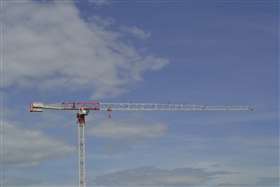
The Terex CTT 202-10 is built ready to receive installation of the Terex tower telematics system, T-Link
Flexibility is afforded by being able to use 3.8, 4.5 or 6 m bases and either H20, TS21 or TS16 masts, ranging from 1.6 to 2.1 m square. Maximum hook height is 76.7 m. An 8 tonne version of the crane, the CTT 202-8, will also be available.
Manufacturer HanKook Tower Crane from Korea, exhibiting with its parent company Everdigm, will promote its new HK360L-18 luffing tower crane announced at the end of 2018. The maximum 18 tonnes capacity is available out to 15 m radius and it will lift 2.14 tonnes at the end of its maximum 60 m jib. Starting from its minimum 30 m jib there are seven length configurations. Maximum freestanding height is 50.6 m, on a on a 2.1 x 2.1 m tower extendable in 3 m increments, the company said. Hoist, slew and trolley mechanisms are all under variable frequency control and the cabin includes a full colour touch screen, air con, heating and so on.
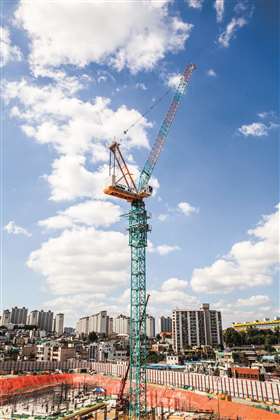
Back to Europe and Wolffkran is launching the 133 B, a hydraulic luffing jib tower crane in the 125 tonne-metre class. It replaces the 100 B and joins the range below the 166 B. Its design, with an hydraulic cylinder instead of a conventional luffing system of ropes, allows a smaller out of service radius. Installation is quicker without luffing ropes to reeve. There are two versions: the 6 tonne capacity 133.6 B with 2.3 tonne tip load at the maximum 45 m radius; and the 133.8 B, an 8 tonner with a tip load capacity of 2.1 tonnes. The basic 25 m jib can be extended in 5 m increments. The 133 B will be supplied on the 2 x 2 m UV 20 tower system giving a maximum freestanding height of 85 m. A connection for a 1.5 m tower is in development, Wolffkran said.
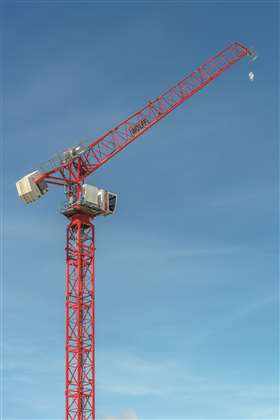
Also on show from Wolffkran will be the Wolff 6020 clear flat top tower, a development of the 6015 clear. It lifts more and incorporates other design elements to benefit operation, erection, dismantling and transport. At the end of its 60 m jib the 6 tonne version can lift 2 instead of 1.5 tonnes while the 8 tonne version manages 1.8 instead of 1.5 tonnes. The 6 tonne version has a 28 kW hoist winch type Hw 628.1 FU with a maximum partial load speed of 108 m/min.
For the first time at a trade show visitors will be able to see the range-topping Wolff 1250 B. While it may not be a new model this 60 tonne capacity luffer is a spectacular sight. This 1,500 tonne-metre class giant has a maximum jib length of 80 m. The 132 kW hoisting winch offers a 190 m/min in single-fall mode. Similarly, the winch drum can carry enough rope for an 800 m lift height.

Italian tower crane manufacturer Gru Dalbe will be present at the show but without exhibits. It will be in the Bauma Plus area in Hall B5. Searching for dealers is the main reason for attending the show, the company said. It is looking to complete its European dealer network and is interested in developing its presence in North America and the Middle East.
The product range includes the DB range of self erectors with jib lengths from 15 to 45 m and the Skycrane brand of larger top slewing models. Largest of the four has a 70 m jib and 10.2 tonne hoist capacity. Launched in 2018 the company’s newest model is a fully hydraulic self erector, the DB 747, with 45 m jib. Capacity is 4.1 tonnes. The first unit was delivered in September.
New in Liebherr’s fast erecting crane series is the 8 tonne capacity 125 K with a radius of 55 m and a maximum hook height of 65.5 m.

New: the Liebherr fast-erecting crane 125 K – currently the largest in its class on the market
It is the largest fast erecting crane on the market, the manufacturer says. Applications include road bridges and other civil engineering projects, commercial and industrial building construction.
Standard hook height is 29.5 m and up to five lattice tower sections can be added to increase hook height to 41.5 m. After that luffing the jib by up to 30 degrees will increase it to the maximum. Capacity at the end of the 55 m jib is 1,300 kg thanks to its Load-Plus function. Radius options are from 35 to 55 metres.
A minimum rear slew radius of 3.2 m is designed to allow operation on increasingly confined spaces of today’s job sites. It is an adjustable radius, however, and can be increased to 4 m which reduces the amount of counterweight needed.
In addition to moving it on a semi-trailer the 125K can be towed as a trailer by a conventional truck using an axle system Liebherr calls LiTrax. It is an 80 km/h high-speed axle for the current fast-erecting crane range. There are three units: a front axle plus a rigid one and then one steerable rear axle. Models 53 K or
65 K.1 can be transported using the front axle and only part of the rear axle. For an 81 K.1 you can use a tandem axle built from two individual rear axle modules.
Manitowoc says it will show several new Potain tower cranes, including units from the flat top and Hup self erecting series. Other interesting new products from Potain will include a range of High Performance Lifting (HPL) winches. Increased productivity for Potain tower cranes is a primary benefit as lifting speeds are up to twice that of the older 75 LVF winch, the manufacturer says. Control is improved with slower creep speeds than the 75 LVF.

Potain’s new HPL series winches are as much as twice as fast as their predecessors
Combining this with new motor brake management and new architecture for maintenance means HPL winches can reduce construction time, improve driving comfort, build quality and load placement, the company says. Further benefits are reduced power consumption and easier maintenance.
The models in the new Potain winch range are: the 75 HPL 25, the 75 HPL 30, the 75 HPL 35 and the 75 HPL 40. Rope capacities range from 539 m to 956 m, and they can be used with a wide range of Potain cranes, including the latest flat tops and luffers. Compatible models include MDT 349 L16, MDT 389 L16, MR 295 H16, MR 225A, MDT 249 J12 and the MDT 269 J10.
Mini cranes
A new telescopic boom crawler on show will be the PCC 57.002 from Palfinger. It is presented as a smaller, more manoeuvrable version of its first crawler crane model, launched in September 2018. In addition to dismantling for easier transport the crane’s modules can be combined in different ways. If not on its crawler tracks the crane can be mounted on a truck or just on stabilisers without any need for the crawler. It makes it suitable for rough ground, jobs on large construction sites or in confined industrial or indoor environments.
Down the capacity scale is Maeda’s latest addition, the CC423 crawler crane. With a capacity of 2.93 tons, the CC423 was developed for use in tight spaces. Features include a small tracked footprint and near zero tail swing, Maeda says.
The main feature is its 1,465 kg pick and carry capacity. Other features include a new engine equivalent to EPA Tier 4 standard, an open but covered superstructure mounted operator’s cab and a gross weight of 4,400 kg.
Mini crane manufacturer Jekko is showing its flagship model, the fully electric SPX532 with rechargeable lithium-ion battery pack. It is good for indoor operation and there is also a diesel engine version. It is designed to be narrow enough to move through a standard width doorway.
Another first from Jekko is a hybrid version of one of its existing models. The SPX1280HYB is an evolution of the SPX1275. It has a three-extension hydraulic jib. Capacity is up from 7,500 to 8,000 kg and there is a new hydraulic system.
Another new evolution model on show will be the JF990, a development in conjunction with Fassi, of the JF545 and JF365. It uses a Fassi loader crane on a Jekko crawler carrier and is claimed as the world’s largest mini crane. The load moment rating is 100 tonne-metres and it weighs a maximum of 23 tonnes, Jekko says.
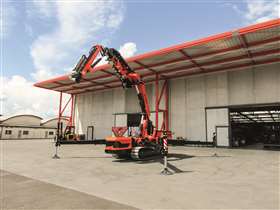
Loader cranes
Hydraulic loader crane and excavator manufacturer Atlas celebrates its centenary in 2019.
New is the N series of models for sale outside Europe. Designed to be simpler, they have no electronics and only enough basic electrics to allow the addition of a radio remote control system. The N-Series versions available to date are 57N, 88N, 116N, 152N, 186N and 292N.
A new construction crane, the 262V ST, will also be shown. It is a 26 tonne-metre model available in A11, A12, A13 and A14 versions. It is aimed at the brick and block market in Germany.
Existing behind-the-cab models 256.3 and 226.3 have been redesigned and updated, saving up to 400 kg in weight per crane over their predecessors, Atlas said. Part of the change is that there is more folded steel and fewer welds, the structure has been optimised using finite element analysis and there is more use of 900 grade high strength steel. They have different electronics and there is a higher level of safety, Atlas said.
As usual at Bauma, Atlas will have its demonstration truck loaded with multiple cranes. Among them will be the 66.3 E articulating model designed for 7.5 tonne trucks. It can have up to four extensions giving a reach of 11 m where the payload is 360 kg. Also on there will be the 96.3 E, typically found on the 12 to 15 tonne truck range and fitted with a gripper.
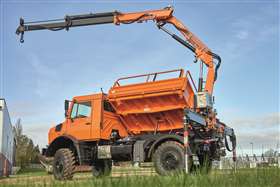
In 2019 Cranab, Fassi’s forestry crane brand, will start production and delivery of the Cranab TZ12 crane. Options for the TZ12 and TL12 crane models will be expanded and products for transport cranes and grippers will also be developed. Other targets for 2019 include the distribution of truck cranes in new markets and to start delivering hydraulic crane clamps.
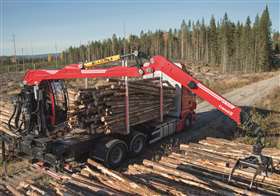
Cranab forestry crane at work
New from Italian brand Effer, now owned by Hiab and part of Cargotec, will be a range of light cranes. It is an Effer design from before the acquisition. At the other end of the capacity scale is the new model 2255. The new 8S base crane can be increased to 10 extensions thanks to two additional ones as part of the KJ system. It allows an articulation height of 35 m. Maximum height of a model designated 8S+KJ2S+XL 65, which means 8+2 sections in the base boom, plus another 8 sections after that, is 58 m. It is possible to configure a crane with the second jib allowing articulation at up to 49 m.

Two new medium range hydraulic crane models will be shown by Fassi. The 30 and 35 tonne-metre models will be used for building materials distribution. Both are XE-dynamic series models with continuous slewing. Versions are available with between two and eight extensions.
At Bauma, Hiab will showcase Hiab FrameWorks the pre-manufactured, fully bolted system with subframe solution to install Hiab loader cranes. The company will also launch BodyWorks, a new Framework product, at the fair. Visitors will also be able to get up close to the Hiab X-HiPro 658 crane. It has a capacity of 58 tm and horizontal outreach of up to 17 metres. Representatives from Hiab’s service network will be available to answer any questions you might have..

New from Hyva is the HC661 hydraulic loader crane in the heavier range. Models are either 60 or 66 tonne-metres, available for CE or non-CE markets. Features include continuous slewing, a double link design, new rotating stabilisers radio control and a jib option.
Also new are mid-range (9-25 tonne-metre) models. Hyva now offers a full line from 1 to 165 tonne-metres. All the new models have a dynamic load diagram function which indicates capacity based on stability. The Magic Touch function automates the folding and unfolding operation to transport and working positions.
New from Hyva sister brand Kennis is the electrically driven E-Power roll loader crane. Benefits are better energy efficiency and no engine exhaust or noise pollution. Light and heavy-duty versions will be available, each with stationary plug-in or on-board mobile charging options.
Ten new models in one series are just some of the new cranes being launched by Palfinger. The new models in the TEC series are rated between 25 and 37 tonne-metres. On show will be the PK 37.002 TEC 7 with continuous slewing, the PK 35.002 TEC 5 with rack and pinion slewing, the PK 30.002 TEC 7 with continuous slewing and the Smart Boom Control function, and the PK 26.002 TEC 3 with rack and pinion slewing. From the 50 to 60 tonne-metre class will be the PK 58.002 TEC 7 prototype and the first ever TEC series crane.
Other new models will include the PK 24.001 SLD 6 and PK 21.501 SLD 3 from the Solid range. These will be the first Solid series models in the heavier 20–25-tonne-metre class.
Moving up the capacity class, a new heavy-duty Palfinger model will be the PK 135.002 TEC 7. Heavy load capability and long outreach are among this crane’s specialities.

The new PK 135.002 TEC 7 is a heavy duty model from Palfinger
An electric concept model on display will be the PK 18502 SH loader crane which has a plug-in electric drive and can also be operated from an on-board battery pack.
Specialized transport
Faymonville will show 13 products on its 1,200 square metre stand, its biggest ever.
Making its debut will be the BladeMax. This trailer is for transporting the newest generation of wind turbine blades. Using the adapter blades can be picked up, elevated to an angle of almost 90 degrees, swivelled and rotated by 360 degrees around their own axis. The unit is mounted on a self propelled vehicle or between modular axle lines and it works without the use of counterweights. It has a maximum load moment rating of 650 tonne-metres, Faymonville says.
Also on show will be the DualMax trailer designed for the North American market. It can be widened in steps from 14 to 20 feet (4.3 to 6 m) loaded out.
Also at the Faymonville stand will be products from the Cometto brand, which is a member of the Faymonville Group. Cometto will show its electronically steered modules, specifically the 6-axle MSPE 48t, on which the Faymonville BladeMax windmill blade transporter is mounted.
A new vehicle concept will be unveiled by Goldhofer on the first day of the show so look out there for more details. Another exhibit will be the four axle TU 4 plant trailer for machines weighing up to 31.8 tonnes. It has new drawbar and improved ramp operation, the German manufacturer says. Also on show will be the STZ-PK 8 low loader semi-trailer first shown at the IAA in 2018 under the name Arcus.

Goldhofer’s display at the 2016 Bauma
Wind turbine blades of 80 m or even longer can be transported on a new third generation system from Tii Group (Scheuerle, Nicolas, Kamag, Tiiger). It is in two parts; a free-turning two axle jeep dolly and then a four axle carrier module. Wind turbine blades are a very sensitive load and need careful handling. Blades can be self loaded without needing a separate crane. The lifting procedure uses a quick coupling with root adapter and a root frame. Lifting height can be altered between -200 and +2,000 mm. Its maximum load moment rating is 610 tonne-metres and it all runs on low maintenance air suspended BPW axles. For empty runs the two units can be coupled together to form a semitrailer combination.
A new generation of Eurocompact trailer is also on display from Tii Group. It has a different tyre size and new regulatory compliance for more European countries.
Tii India has a new 4 axle platform transporter for use in its home region. The modular Tiiger Smart Duty (SD) is for loads up to 240 tonnes. Capacity per line on the hydraulic axles is 18 tonnes and the maximum steering angle is 53 degrees.
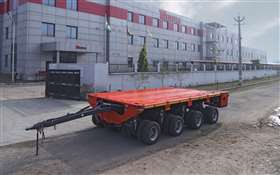
Specialized lifting equipment
Industrial and heavy lifting equipment specialist Enerpac will launch an hydraulic gantry lifting system and trolley and cube jack systems.

Enerpac’s new 100 and 200 tonne capacity lifting gantry systems run on 610 mm wide tracks
A feature of the new SL100 and SL200 gantries is that they run on a narrow, 610 mm wide track. Capacity is 100 and 200 tonnes on the two stage lift cylinders. Maximum lifting height is 4.75 m on the SL 100 and 6.7 m on the SL200.
The ETR1250 trolley system is an alternative to traditional skidding and it has benefits, Enerpac says. Electrically-driven trolleys carry heavy loads along a fixed rail system. Compared with skidding systems, the electric trolley offers continuous movement, instead of the stroke extend and retraction cycle of an hydraulic cylinder system. It means significantly faster travel, the company says.
Also new is the SCJ50 50T Cube Jack. It is an alternative to traditional climbing jack systems and operates like the company’s existing jack-up system for heavy loads but without electrical controls. Cube Jack is described as a safer alternative to jacking and packing with wooden cribbing. It has a smaller footprint and gives a more stable lift to a height of 2 m and where space to operate is restricted.
Blocks are stacked manually and there is a mechanical lock both on the up stroke and down stroke. Operation is incremental with the lock engaging at the end of the extension stroke whereupon the lift cylinder is retracted and another packing block can be added.




